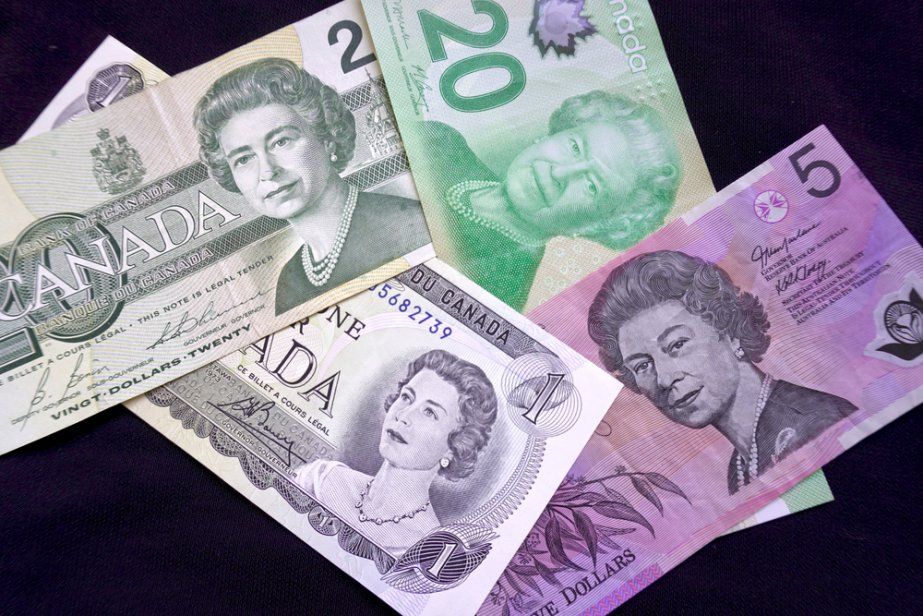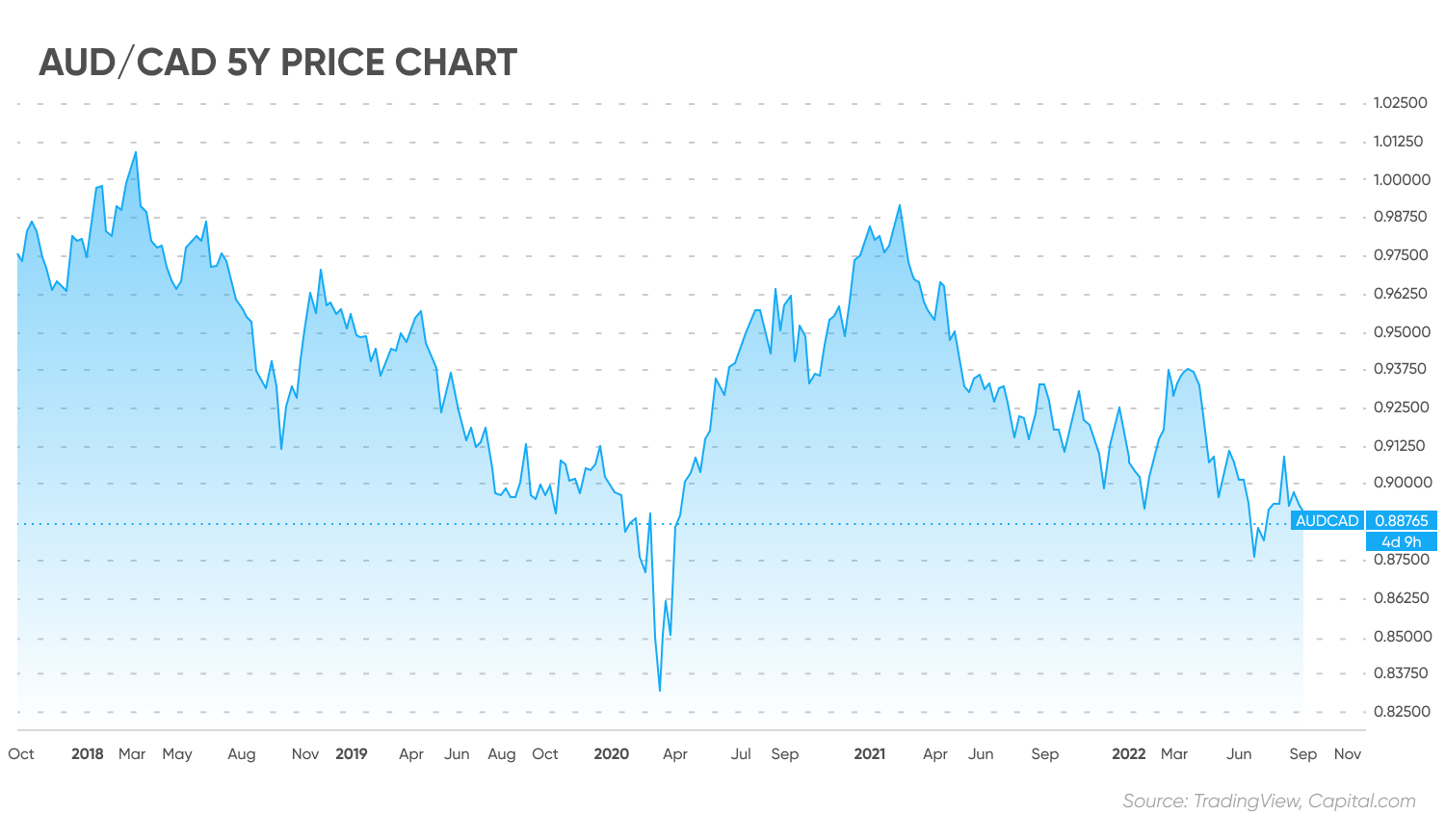AUD/CAD forecast: Australian dollar falls behind Canadian counterpart in pairing of global mining giants
AUD/CAD has fallen over 7% from early April as commodity prices fall, China sticks to its strict zero-COVID position, and oil hits a 9-month low. Read on for some of the latest AUD/CAD forecasts.
The Australian dollar to Canadian dollar currency pair (AUD/CAD) has fallen over 7% from early April as commodity prices fall, China sticks to its strict zero-Covid policy and oil hits a 9-month low.
AUD/CAD live price chart
Read on for some of the latest AUD/CAD forecasts.
What is AUD/CAD, and what are its primary drivers?
The Australian dollar is the official currency of Australia and several other countries and territories, such as Christmas Island and the Coco Islands, among others. The Aussie came into circulation in 1966 and is issued by the Reserve Bank of Australia (RBA).
The Canadian dollar is Canada’s official currency. Introduced in 1858, it’s issued by the Bank of Canada (BoC). The CAD is the fifth most held reserve currency globally after the USD, EUR, GBP and JPY. It is the sixth most traded currency.
Both the Australian and the Canadian dollars are known as commodity currencies. This is because the Australian and Canadian economies are large exporters of commodities, particularly metals.
Australia is the world’s largest exporter of iron ore, coal and aluminium oxide, and one of the largest exporters of gold. Meanwhile, Canada depends heavily on crude oil, gold and raw aluminium exports.
As a result, these currencies are influenced by price fluctuations in those commodities, hence the name commodity currencies.
The Canadian economy is more dependent on the US, its largest trading partner. Any severe hit to the US economy hurts the Canadian economy. Meanwhile, the Australian economy depends more on trade with China and other south-east Asian economies.
Other factors affecting these two currencies include the broader economic picture reflected in macroeconomic data points such as unemployment levels, inflation, gross domestic product (GDP) and retail sales.
The countries’ central banks, the RBA and the BoC, make monetary policy decisions. While tightening monetary policy will lift a currency, loosening monetary policy can often pull a currency lower.
AUD/CAD historical price movement

In February 2012, AUD/CAD traded at a record high of 1.08. The Aussie maintained its strength versus the loonie until mid-2013, when the pair fell briefly to a low of 1.9170.
By early 2014 the pair had regained upwards momentum, rising to the 1.03 level.
For the next four years, the price traded relatively range-bound, capped on the upside by 1.03 and rarely falling below 0.94 – until Covid-19 struck, pulling the price to a low of 0.8070, a level last seen in 2009.
The AUD/CAD rebounded firmly from here, rising to 1.00 in February 2021.
The pair has been trending low over the past 18 months, falling to its current level of 0.89 as of 27 September.
How has the AUD/CAD traded across 2022 so far?
The AUD/CAD started 2022 at around 0.92 before steadily falling across January to a 20-month low of 0.8910. From there, the pair rebounded, with the Australian dollar (the Aussie) strengthening against its Canadian peer (the loonie), rising to a yearly high of 0.9516.
From this 2022 high, the Aussie started weakening against the loonie, falling steadily across the second quarter of 2022 to a low of 0.8750, a level last seen when the Covid-19 pandemic hit in April 2020.
While the pair has recovered from this 2022 low, the AUD/CAD trades below 0.90, with further weakness threatening to push the pair to new 2022 lows.
AUD/CAD latest developments
Commodity currencies have come under pressure over the last six months as the overall global growth picture has deteriorated, pulling commodity prices lower. As central banks began hiking interest rates to tame surging inflation, the growth outlook has slowed.
Slowing growth cools the demand outlook for commodities, pulling prices down. This is particularly the case for China, the world’s largest consumer of metals and Australia’s lead trading partner. Growth in China has been a concern due to strict measures to control the spread of Covid-19. Lockdowns, travel restrictions and mass testing have taken their toll on the economy, resulting in growth faltering and the risk of a recession looming large.
The OECD, in their report released on 26 September 2022, noted that global economic growth is slowing more than was expected a few months ago amid fallout from Russia’s invasion of Ukraine, high energy prices and rising inflation.
The OECD expects the Chinese economy to grow 3.2% this year and 4.7% next year. This was revised down from 4.4% in 2022 and 4.9% in 2023.
Demand for input from China is one of the key factors influencing the prices of oil, metals and other commodities worldwide. Covid-zero policies and the housing market crisis have put China’s economic growth behind the rest of the Asia-Pacific region for the first time in more than 30 years, according to forecasts from the World Bank.
In a report released on Monday, the US-based institution said the annual growth outlook for East Asia and the Pacific region had been downgraded from 5% to 3.2%. The majority of that decline, however, was attributed to economic woes in China, which constitutes 86% of the region’s economic output. The World Bank’s report forecast China’s GDP to grow 2.8% for 2022, and the rest of the 23-country region to grow 5.3% on average – more than double the 2.6% rise in 2021.
Sticking with commodities, the loonie is also affected by oil prices, which have fallen over 35% since June, trading at the lowest level for nine months. As with metals, the demand outlook for oil is cooling as recession fears rise.
Meanwhile, economic growth in Australia has held up at around 3.5% in 2022. However, the RBA has also raised interest rates aggressively to control inflation, which is expected to start denting demand from households and businesses going forwards.
The RBA has increased rates by 225 basis points. RBA Governor Philip Lowe considers that the central bank could soon be approaching the end of big hikes.
Canada’s economy is growing at an annual rate of 2.9% in Q2. Analysts at the National Bank of Canada put this down to Canadian producers still selling at historically high price levels, despite the recent slowdown in commodity prices.
The high prices are boosting Canada’s current account balance, which recorded a surplus in Q2 for the first time in 14 years. The impact of EU sanctions on oil prices could further support the sector.
External trade supports the domestic economy and, therefore, the currency. Household disposable incomes remain strong.
AUD/CAD forecast: 2022 and beyond
While the Aussie has been weakening across the past six months, is this trend likely to continue? Let’s see what the analysts think.
In their AUD/CAD forecast, analysts at the National Bank of Canada (NBC) said that the Australian dollar will appreciate against the Canadian dollar in the coming quarters.
The NBC’s Australian dollar to Canadian dollar prediction has the pair rising to 0.90 by the end of September. According to the bank, the currency pair could continue rising to 0.91 by the end of Q1 2023 before potentially jumping to 0.95 by the end of Q2 next year.
Meanwhile, analysts at National Australia Bank (NAB), in their AUD/CAD forecast for 2022, see the pair rising to end the year at 0.9, increase further to 0.91 in Q2 2023 and hitting 0.93 by the end of 2023.
As of 27 September, analysts at data aggregator TradingEconomics considered that the Aussie could weaken against the loonie by the end of the quarter, with the pair predicted to fall to 0.8792. Its AUD/CAD forecast predicted the pair could continue to drop in 2023, falling to 0.8621 over the coming 12 months.
Algorithm-based forecaster WalletInvestor was more upbeat about the prospects for the Australian dollar, expecting it to strengthen in the near term. The service’s AUD/CAD forecast had the pair ending 2022 at 0.8950. However, its AUD/CAD forecast for 2025 saw the Aussie holding steady against the loonie and the pair staying at 0.89 by the end of the year.
Meanwhile, algorithm-based service AI Pickup was more bullish still on the Australian dollar. In its AUD/CAD forecast for 2025, the platform predicted that the pair will rise to 1.04. The website’s AUD/CAD forecast for 2030 had the pair rising to 1.05.
It is important to remember that analysts’ and algorithm-based Australian dollar to Canadian dollar forecasts can be wrong. Always conduct your due diligence before trading, looking at the latest news, technical and fundamental analysis, and analyst commentary.
Past performance does not guarantee future returns. And never trade money that you cannot afford to lose.
FAQs
Why has the AUD/CAD been dropping?
Both currencies have come under pressure as commodity prices have fallen. The Aussie has fallen further than the CAD, possibly due to a sharp slowdown in China, its main trading partner.
Will AUD/CAD go up or down?
Whether the AUD/CAD goes up or down could depend on the outlook for the Australian economy compared to Canada’s if the RBA starts slowing rate hikes ahead of the BoC, and whether China’s economy suffers more Covid-related lockdowns.
Analysts at Canadian bank NBC have forecast that the currency pair could continue rising to 0.91 by the end of Q1 2023. Data aggregator TradingEconomics has forecast AUD/CAD to fall to 0.8621 over the coming 12 months.
Remember that analysts can and do get their forecasts wrong. Always do your own research. And never invest more money than you can afford to lose.
When is the best time to trade AUD/CAD?
The best time to trade AUD/CAD is when the currency pair is most volatile. This is usually between 19:00 and 04:30 GMT, when there is some crossover in the opening hours of the Canadian and Australian stock markets.
Is AUD/CAD a buy, sell or hold?
Whether you consider the AUD/CAD a buy, sell or hold is a personal decision. You should conduct your own research to understand the latest market trends, news and analysis, basing your decision on your risk tolerance, investing strategy and portfolio composition. Keep in mind that past performance is no guarantee of future returns. And never invest money you cannot afford to lose.